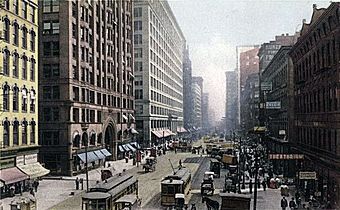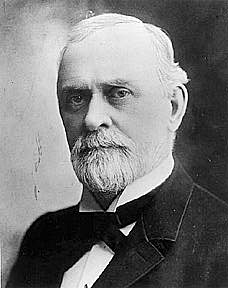Loop Retail Historic District facts for kids
Quick facts for kids |
|
|
Loop Retail Historic District
|
|

State Street in 1907
|
|
| Location | Chicago, Illinois |
|---|---|
| Area | 26 acres (11 ha) |
| Built | 1871 |
| Architect | Holabird and Roche; Sullivan, Louis Henri, et al. |
| Architectural style | Italianate, Early Commercial, Chicago |
| NRHP reference No. | 98001351 |
| Added to NRHP | November 27, 1998 |
The Loop Retail Historic District is a special shopping area in Chicago, Illinois. It's known for its many historic buildings. This district is found in the heart of downtown Chicago, between Lake Street to the north and Ida B. Wells Drive to the south. State Street is to the west, and Wabash Avenue is to the east.
This area has the most buildings in Chicago that are recognized as important landmarks. These include buildings listed on the National Register of Historic Places and Chicago Landmarks. Some famous buildings here used to be big department stores. These include the Marshall Field and Company Building (now Macy's) and the Sullivan Center (which was once Carson, Pirie, Scott and Company). The district was added to the National Register of Historic Places on November 27, 1998. It includes many historic buildings, some of which are very famous. Other important buildings are the Joffrey Tower, Chicago Theatre, and Palmer House. DePaul University also has its College of Commerce here.
This district is most famous for its large department store buildings. In the past, seven major department stores were located here. Six of these original buildings are still standing today. Besides Marshall Field's and Carson, Pirie, Scott, another notable building is the A. M. Rothschild & Company Store at 333 S. State St. The other department store buildings also add to the district's historic value.
History of the Loop Retail District
The most important historical period for this district was from 1872 to 1949. In the late 1860s, a man named Potter Palmer helped make State Street better. He built his own Palmer House hotel there in 1870. He also convinced Marshall Field and Levi Leiter to move their store, Field, Leiter & Co., to State Street in 1868.
After the Great Chicago Fire of 1871, State Street became the main shopping area in downtown Chicago. It was easy for people to get there using public transportation like streetcars and elevated trains. This made State Street a popular shopping spot from Lake Street to Van Buren Street. By the 1900s, State Street was a major shopping destination. It was even mentioned in Frank Sinatra's song "Chicago (That Toddlin' Town)," where he called it "State Street, that Great Street." At one time, seven big department stores were on State Street. These included Benson & Rixon, Karolls, Charles A. Stevens, and Mandel Brothers, along with Marshall Field's and Carson, Pirie, Scott.
Over time, Chicago changed. By the 1920s, towns outside the city began to have their own shopping areas. After 1950, more people moved to the suburbs. This meant fewer people came downtown to shop every day. However, the Magnificent Mile area kept a fancy shopping district close to the city center.
In 1979, Chicago Mayor Jane Byrne turned part of State Street into a pedestrian mall. Only buses were allowed on the street. Later, Mayor Richard M. Daley started a project to improve State Street. On November 15, 1996, the street was reopened to regular traffic. Today, the Chicago Transit Authority's Red Line subway serves State Street. The elevated trains of the Chicago 'L' also run along Wabash and Lake streets in this district. The area is still being improved to welcome students and new residents who live nearby.
Gallery
-
Carson Pirie Scott Building on Lincoln's 100th Birthday
-
Palmer House Hotel Ladies Entrance
-
Masonic Temple, 1900
-
Masonic Temple with new Marshall Field and Company Building, 1911










